Sign up for Lesson Plans, discounts & more!
The Gallery of Minerals
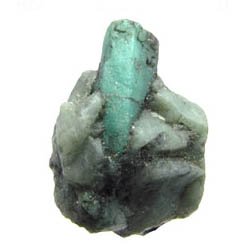
Minerals are very important. We study them because they play a major role in our economy, industry, and health. We use hundreds of products everyday.
The following are examples of common minerals that are categorized by type. Each has a thumbnail picture of the specimen and a brief description of it. Clicking on the name of the individual specimen will take you to a page with a larger picture and a detailed description.
But before we get to individual specimens lets see if we can agree on what these things are. A scientific definition says that it is something that:
- occurs naturally.
- Is solid at room temperatures
- has a regular structure (its atoms have a definite arrangement).
- Has a chemical formula
There are a few things that don’t seem to fit even though they seem to belong. See mineraloids.
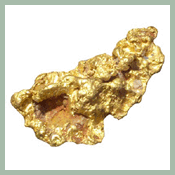 |
Gold is a soft metallic element. Its symbol is Au. It is very dense. As one of the noble metals it is resistant to corrosion and oxidation in moist air. | ||||||||||
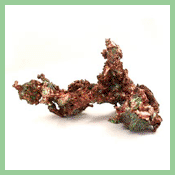 |
Copper is a soft metallic element. Its symbol is Cu. Native copper is rare because it has been mined for centuries. Today it is used for making wire, tubing, and coins to name a few. Long ago it was combined with tin to create bronze. | ||||||||||
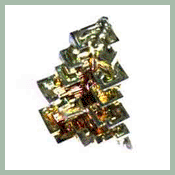 |
Bismuth Crystals Bismuth in its elemental form is a rare occurance in nature, even more so for bismuth crystals. Lab grown crystals are popular because of their intricate shapes and dazzaling colors. | ||||||||||
| Silicon Silicon is a metallic element used to make computer chips and other electronic equipment. Although it is the second most abundant element in the world it was not discovered until 1824. | |||||||||||
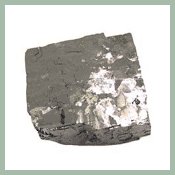 |
Galena has been mined for lead and silver since the time of the Romans. It is a form of lead sulfide. The chemical formula is PbS. It is the most important source of lead and is abundant and widespread in occurance. | ||||||||||
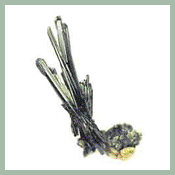 |
Stibnite Stibnite is a sulfide found in low temperature hydrothermal veins and hot springs deposits. It is prized by collectors for the long slender bladed crystals. These can occur in clumps with many orthorhombic crystals radiating in all directions. It is very soft only a 2 on the Mohs hardness scale. | ||||||||||
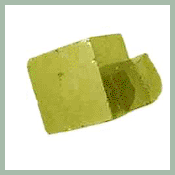 |
Pyrite sometimes called iron pyrite is a compound of iron and sulfur, iron sulfide FeS2. Depending upon the conditions under which it forms pyrite can form crystals of different shapes. | ||||||||||
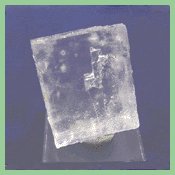 |
Halite Halite is also known as rock salt. The chemical name is sodium chloride NaCl It is called an evaporate. It forms in places where sea water has been isolated from the ocean forming a lake. | ||||||||||
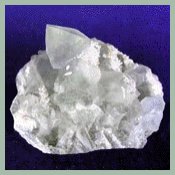 |
Fluorite Fluorite is a halide that is soft and usually colorless but can be blue, purple, green, brown, or yellow. Some times several colors are present in the same crystal creating a striking affect. | ||||||||||
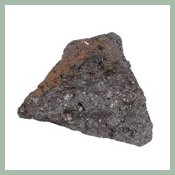 |
Magnetite is sometimes called lodestone. It is strongly magnetic. It was used by the ancient Chinese to make the first magnetic compasses. The chemical formula is Fe3O4. | ||||||||||
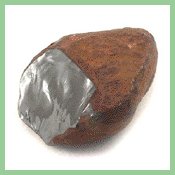 |
Hematite is one of the most prevalent and useful forms of iron on our planet. It is a common iron ore and is often used in jewelry and other decorative items. The chemical formula is Fe2O3. | ||||||||||
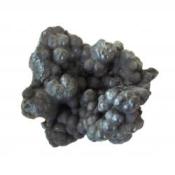 |
Goethite Goethite is a common mineral that belongs to the oxide group. It has the chemical formula FeO(OH) and often contains varying amounts of other elements such as aluminum, manganese, and titanium.3O4. | ||||||||||
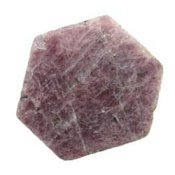 |
Ruby Ruby is a red corundum mineral with a chemical formula A 2 O 3 aluminum oxide with chromium. It is the chromium that give rubies their red color. | ||||||||||
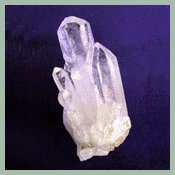
|
Quartz is one of the most common of all minerals that make up the continental crust. It is composed of silicon dioxide SiO 2. It is found in igneous, metamorphic, and sedimentary rocks. It is associated with many valuable ore deposits as well. | ||||||||||
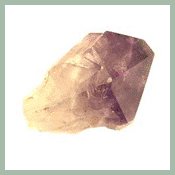
|
Amethyst is a variety of quartz and owes its purple color to the presence of iron. It is composed of silicon dioxide SiO 2 . | ||||||||||
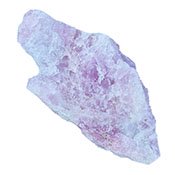
|
Rose Quartz is a variety of quartz and owes its pink color to the presence of titanium, iron, and manganese. It is composed of silicon dioxide SiO 2 . | ||||||||||
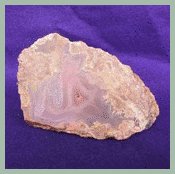
|
Agate is the name given to a group of oxides that are made up primarily of chalcedony. Chalcedony is a member of the quartz family of minerals. Like quartz chalcedony is silicon dioxide with a chemical formula of SiO 2 . | ||||||||||
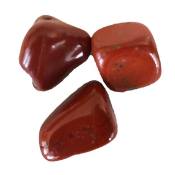
|
Jasper is the name given to a group of oxides that are part of the quartz family of minerals. Like quartz it is silicon dioxide with a chemical formula of SiO 2 . | ||||||||||
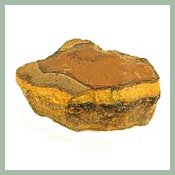
|
Tigers Eye is a form of quartz with some special characteristics. Like all quartz it is made up primarily of silicon dioxide, SiO 2 . Within this matrix are asbestos fibers usually occurring in layers. It is the asbestos that makes Tiger eye a chatoyant gemstone. | ||||||||||
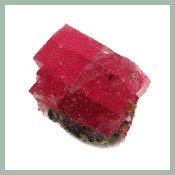 |
Rhodochrosite is a manganese carbonate mineral. Its chemical composition is MnCO3. In its purest form it is a transparent rose red, but this is fairly rare. It can also be formed in stalactites. This form can be sliced revealing circular layers of rose and pink to milky white. These lighter colors are formed when the manganese is replaced by calcium, manganese or zinc. The depth of color from red to pink depends on the amount of substitution. | ||||||||||
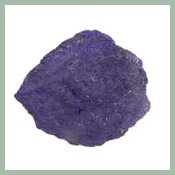 |
Azurite is a copper carbonate. The chemical formula is Cu3[OH CO3]2and results from the oxidation of copper sulfides. | ||||||||||
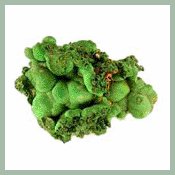 |
Malachite is a copper carbonate with a chemical formula of Cu2[(OH)2 CO3]. It is a vibrant green color often banded with light and dark greens. | ||||||||||
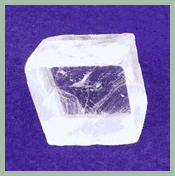 |
Calcite Calcite is a very common sedimentary mineral. It has the chemical formula CaCO3 calcium carbonate. Calcite dissolves in water and so is carried along with water into cracks, fissures, and caves. It can over time build up layer upon layer to form stalactites and stalagmites in caves. | ||||||||||
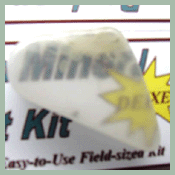 |
Ulexite is a hydrated sodium calcium borate hydroxide mineral. Its chemical composition is NaCaB5O6(OH)65H2O. It is an evaporate with closely packed parallel fibers that are able to transmit light. | ||||||||||
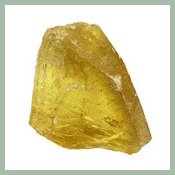 |
barite is a sulfate mineral with a chemical formula of BaSO4, sometimes called heavy spar. Its chemical name is barium sulfate. It is the primary source of the element barium. | ||||||||||
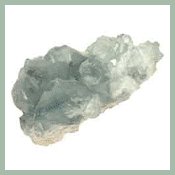 |
Celestite is made up of strontium sulfate. The chemical formula is SrSO4. Its name comes from Latin, caelestis meaning celestial. | ||||||||||
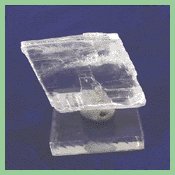 |
Selenite is a very common chemical sedimentary mineral. Its chemical formula is Calcium Sulfate dihydrate CaSO42H20, It is a form of gypsum. It is a very soft mineral. | ||||||||||
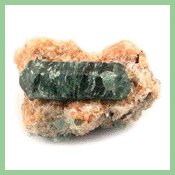 |
Apatite is the name given to a group of phosphate minerals that are widely distributed in all rock types, usually in tiny crystals spread throughout the host rock. It is usually green in color. | ||||||||||
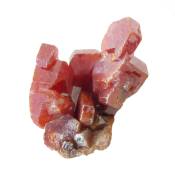 |
Vanadinite Vanadinite is a natural occurring phosphate mineral from the apatite family. It is made up of vanadium, chlorine, oxygen, and lead. Its chemical formula is Pb5(VO4)3Cl. | ||||||||||
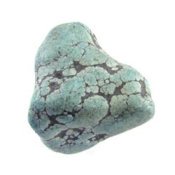 |
Turquoise is classed as a phosphate mineral. The chemical formula is CuAl6(PO4)4(OH)8 4H2O a hydrous phosphate of copper and Aluminum. | ||||||||||
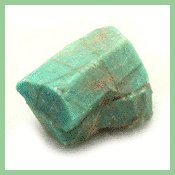 |
Amazonite is a beautiful green variety of microcline feldspar. Its chemical formula is KAlSi3O8 , potassium aluminum silicate. | ||||||||||
| Lapis Lazuli is a beautiful deep blue silicate mineral made of 25% to 40% lazurite with calcite, sodalite and pyrite mixed in. | |||||||||||
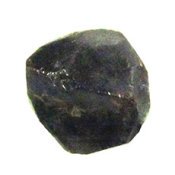 |
Garnet Garnet is a group of silicate minerals with six distinct varieties. It is widely used in jewelry making and as an industrial abrasive. The chemical formula is X3Y2Si3O12. | ||||||||||
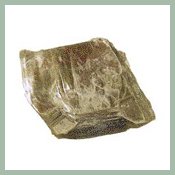 |
The Mica Group is the name given to a group of silicate minerals that have silicon and oxygen as their two major components. | ||||||||||
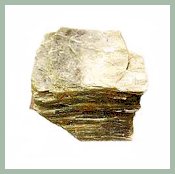 |
Muscovite is a member of the mica mineral group. It is more important as a rock-forming mineral than as a collectible specimen | ||||||||||
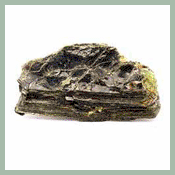 |
Biotite Biotite is a member of the mica branch of the silicate mineral group. It is common as a rock-forming mineral and is present in all three rock types: igneous, metamorphic, and sedimentary. | ||||||||||
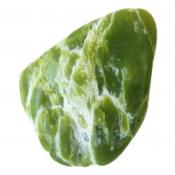 |
Serpentine Serpentine's chemical formula is typically represented as (Mg,Fe,Ni,Al)3(Si,Al)2O5(OH)4, reflecting its variability in cation composition. The proportion of magnesium, iron, nickel, and aluminum may differ among individual serpentine samples, resulting in a diverse range of mineral compositions within the serpentine group. | ||||||||||
| Lepidolite is a member of the mica mineral group with pink and purple colors. | |||||||||||
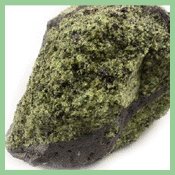 |
Olivine is a group of minerals that come from magma. It is important as a rock-forming mineral. | ||||||||||
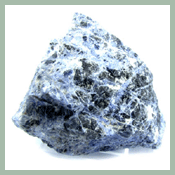 |
Sodalite is a deep royal blue silicate. The deep color and the fact that it will take a high polish makes it popular in jewelry and other decorative items. The chemical formula is Na8Al6Si6O24Cl2. | ||||||||||
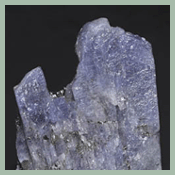 |
Tanzanite is a variety of Zoisite. It is valued as a gem stone and has the chemical formula Ca2Al3Si3O12(OH). | ||||||||||
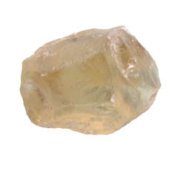 |
Topaz is a silicate mineral that can be many different colors. The fact that it will take a high polish and is very hard makes it popular in jewelry. The chemical formula is Al2SiO4(F,OH)2. | ||||||||||
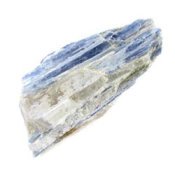 |
Kyanite is a silicate mineral that can be blue, black, green, and orange. It commonly forms bladed crystals but can form masses and occasionally beautiful transparent crystals prized as gemstones. | ||||||||||
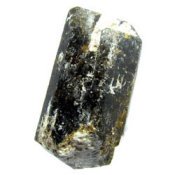 |
Tourmaline Tourmaline is a unique crystalline boron silicate mineral and comes in a variety of colors, such as watermelon, rainbow, black, green, and purple.
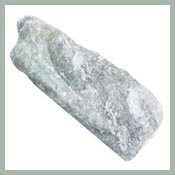 Talc is a metamorphic mineral from the silicate family. Its chemical formula is hydrated magnesium silicate H2Mg3(SiO3)4. Talc is commonly used as talcum powder to reduce friction, promote dry skin, and prevent rashes.
| 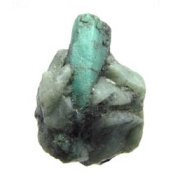 Emerald is the green gemstone variety of the mineral Beryl with the chemical formula Be3Al2(SiO3)6), beryllium aluminum silicate.
| 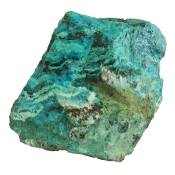 Chrysocolla is a blue green silicate mineral with the chemical structure hydrated copper silicate and formula: ( Cu,Al)2H2Si2O5(OH)4. nH2O. It is a minor ore of copper and is found associated with other copper minerals.
|
| 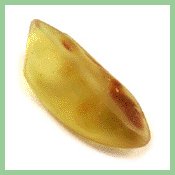 Mineraloid is the term used for those substances that do not fit neatly into one of these eight classes. Opal, jet, amber, and mother of pearl all belong to the mineraloids.
| | |||||
Minerals For Sale

INTERESTED IN MORE? IF SO, YOU MAY WANT TO CHECK OUT OUR OTHER SITES:
fossilicious.com - Our online fossil and mineral rock shop.
fossils-facts-and-finds.com - An educational site about fossils.











